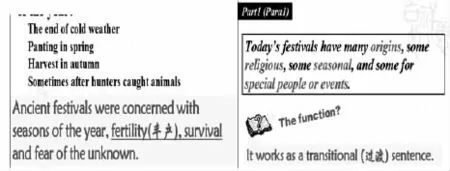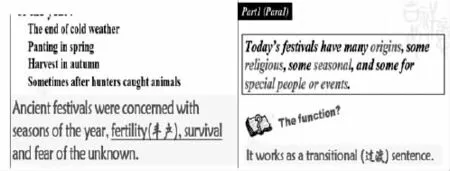高中英语阅读教学中高阶思维品质培养的策略研究
2018-06-28史斯
史 斯
(浙江省宁波市鄞江中学)
语言是思维的工具,也是人们交流思想的工具。思维是语言的核心要素。英语要为思而教,这个观点已经普遍受到英语专家和教师们的认同。阅读是高中英语教学的重要内容,教师应对英语阅读教学文本进行深入解读,使读者与语篇之间进行互动,对其阐述的观点或隐含的信息进行深层次理解和评鉴,从而促进学生评判性思维能力的发展。笔者结合具体教学案例,总结了以下几点日常阅读教学设计思路上较为实用有效的策略。
一、细微处见真章(以文本中不起眼词汇为切入点)
【课例片段1】:人教版高中英语必修教材第三模块第二单元Healthy eating的阅读文本讲述了王鹏和永慧的餐厅竞争故事。文章第一段中作者向读者展现了王鹏那空荡荡的无人光顾的餐厅。许多老顾客匆匆经过,却不进去吃饭,包括好朋友老李。当王鹏向老李打招呼的时候,Li Chang seemed not to hear。笔者在解读文本过程中,对seem这个词产生了浓厚的兴趣。在教学过程中,教师向学生提出如下疑问:
T:Why does the writer use“seem”?What can we infer from this word?
Ss:“Seem” means something not real.So Lao Li must have been pretending not to hear Wang Peng’s words,which implied Lao Li wasn’t willing to enter Wang’s restaurant as usual.Maybe he didn’t like Wang’s food.
【说明】学生的阅读兴趣因为看似简单的seem一词而被调动,立足整体篇章立意,思维顺畅生长,对文本内容进行预测和自我评判,所学的语言积累也得到输出,对于接下去的文本内容的学习和探索欲被充分激发。
【课例片段2】:人教版高中英语必修教材第三模块第五单元的单元话题是Canada——“The True North”,而单元阅读文本的题目是A trip on“The True North”。两处都用到了“The True North”,如不细心研读,会容易认为所指都为加拿大这个国家。但笔者研读后产生以下思考,如果都指加拿大这个国家,标题中为什么不表达成A Trip in或者around“The True North”呢?on这个介词的使用是有什么特殊含义吗?因此标题中on这个介词就是一个很好的思维激发点,启发学生思考标题中“The True North”的真正含义。故教学中笔者提问如下:
T:What does“The True North” in the title refe to?Why did the writer use“on” rahter than other prepositons?
在教学过程中学生带着此疑问,饶有兴趣地从文本中找出相关支持信息:
Ss:He was going to take them and their baggage to catch“the True North”——the cross-canada train.“The True North”refers to the train.We usually use“on a train” instead of“in a train”.
学生恍然大悟,原来标题中的“The True North”指的是以“The True North”命名的列车。因此也能进一步理解为何介词使用的是on而不是其他。
【说明】此案例中,一个小小的介词引发的思考就是学生对文本进行审视和质疑的过程,通过提供足够的证据对自己的观点进行合理的支撑,这就是评判性思维的生长过程。
二、层层铺垫,环环相扣(教学过程中以问题链形式促思维生长)
【课例片段3】:人教版高中英语必修教材第三模块第一单元Festivals and celebrations一课中,笔者在学生第二次精读文本时进行以下提问:
Q1:Festivals have already existed since the ancient times, and when did they celebrate?
Q2:Then why would people celebrate at these times of the year?
Q3:What about festivals today?Which sentence do you think tells the origins of today’s festivals?


【说明】问题一“古代节日庆祝的时间是什么时候”属于展示型问题,学生很容易在相应的段落里找到答案。教师顺接着此问题继续提问“为什么要在这些时间里举行庆祝”,此问题建立在第一个问题的基础上,是对第一个问题的发展。答案无法在文本里找到,真正用意在于让学生联系已有知识积累展开思考,形成自己的理解和判断。
【课例片段4】:人教版高中英语必修教材第三模块第一单元Festivals and celebrations一课中,介绍到不同文化民族对亡灵节日(Festivals of the Dead)的对待方式。该教学过程中不仅让学生了解中西方民族对待亡灵节的相似性和区别,更要启发学生思考其背后的文化差异。教学过程设计如下:
Step2:Detailed Reading(Para2 Festivals of the Dead)
T:Ok.Let’s move to the “Festivals of the Dead”,including Obon,Day of the Dead and Halloween.Can you read the sentence that tells the origin?
Ss:Some festivals are held to honor the dead or to satisfy the ancestors,who might return either to help or to do harm.
T:Why did they do so? What’s people’s common belief about the origin?
Ss:They believed in the return of the spirits(亡灵)of the dead ancestors.
T:Does China have such kind of festival?
Ss:In fact,China also has a similar festival“Qingming Festival”.
T:So would you compare these four festivals and list their similarities and differences?
Ss:Similarities:(Japan&China&Mexico)clean graves and offer gifts to the dead.Differences:Mexicans eat special food that look like bones while other countries don’t.On western Halloween,Children dress up and play tricks to have fun.
T:Quite good.From what you’ve found,can you see people’s different attitudes to death?
Ss:Asian people are more serious about death while westerners view death in a more humorous way,which is also a reflection of different culture and customs.
【说明】确实,亚洲国家譬如中国、日本等多以扫墓等严肃的方式祭奠逝去的亲友;而西方国家庆祝万圣节的时候,人们则会化装打扮互相捉弄,以更为诙谐幽默的态度来度过亡灵节日。对待亡灵节日的方式折射出的是世界上不同民族的文化传统和习俗的差异性。
总之,阅读教学中教师应该尽可能地运用各种有效策略和手段,动态启发学生的思维,在不经意间学生的思维将得到激发与生长;同时借助文本语境,融合文化内涵,使思维顺势开阔,从而推动思维的跨文化交流。
[1]张惠娥.高中英语文学阅读“为思而教”的导学实践[J].中小学外语教学(中学篇),2015(3).
[2]葛炳芳.对教学材料使用的探讨[J].教学月刊中学版,2009(8).
[3]朱紫菁.浅谈高中英语文本的多视角解读运用[J].中小学英语教学与研究,2015(7).
